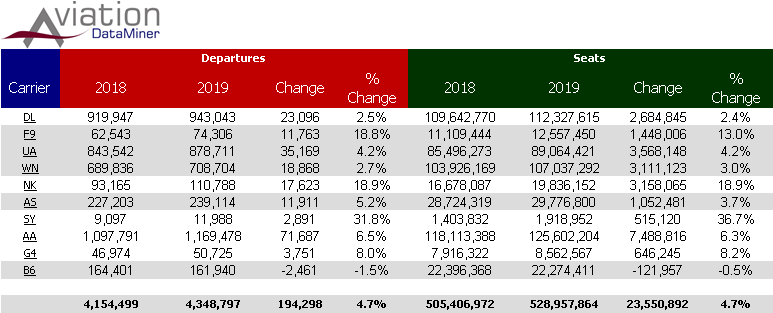Forecast Projections At The IAFS…
A Robust 2019 Second Half – A Disruptive 2020
While the Max saga continues, the US will still be looking at very strong traffic growth for the remainder of 2019.
As it stands today, the US airline industry is planning to put nearly 5% more flights and seats into the domestic skies over the next six months.
On the surface, this indicates stability in the air transportation system… but a deeper look indicates a lot more disruption than expected.

Disruption: What these data don’t show is that the distribution of this growth will continue to change the air service picture – it isn’t a level playing field across the board.
A foundation is being laid for some very fundamental changes in the US air transportation system for 2020. For starters:
Rural/Small Community Air Service: Economic Gravity Will Finally Take Hold. At the 2019 International Aviation Forecast Summit, we’ll be exploring how global connectivity will begin to replace the Luddite schemes to establish air service at small airports that have zero chance of supporting it.
This race has been run… the desperate attempts at jive studies to “lure” airlines to small airports will finally start to shift toward planning to assure regional connectivity to the global economy. This means waking up and smelling the fumes on the interstate highways… air travel is multi-modal, and the assumption that air service is essential at every local airport is bogus. And impossible to achieve.
Geographic “Catchment Areas” – Replaced By Consumer Access Stratas. The obsolete approach of drawing a perimeter around a small or medium airport, and declaring it a “catchment area” sounds logical. But it flies in the face of consumer realities and airline system economics. The name of the new game is determining the specific stratas of consumer capture that an airport can achieve, based on the service levels it can support.
In no case is it 100%, and in no case is it any longer a geographic issue alone.
Depending on the range of alternative consumer options, the “catchment” is now based on consumer needs. The local service at a small airport will meet some of these needs. But when there is access to dozens of LCC flights at another airport 75 minutes away, to believe that all local consumer travel “belongs” to the local airport is malarkey. This service meets the needs of some local consumers, but to imply that those that don’t take flights at the local airport are “leakage” is not accurate and not productive to futurist access planning. In many cases, the local area is part of that distant airport’s catchment- consumer access – region.
Regional Preference Shifts Due To New International Service. We’ve noted how EU and UK airlines (and in some cases, their US airline alliance partners) will be adding hub spokes to US non-hubsite and secondary cities. But having more international flights out of airports, such as for example, Louisville, will raise their profile and role as a regional gateway for domestic service as well.
Discretionary Spend Shifts – The ULCC Roller-Coaster. Day-of-week ULCC service at mid-size airports, based on providing an alternative use of discretionary dollars, can come and go in a near heartbeat. In regions with strong influx of new industry – plan on traffic spikes. But do watch regions were local industry is moving out. ULCC service can move with it.
Plus, it’s important to understand that most ULCC service is not based on core air service demand, but instead on creating net-new traffic based on a new spend option. That spend can be exhausted – and the ULCC can and will move on.
Join Us At The International Aviation Forecast Summit To Explore More. Certainly, American Airlines, United, Delta, Southwest, Spirit, and more than a dozen other airline CEOs and executives have their own perspectives on these and other issues that will shape the future… so join your colleagues August 25-27 in Las Vegas, and hear them.
New visions, new concepts… this is what the IAFS is all about. If you haven’t registered, click here to do so now.
It’s going to be a very different 2020 – we look forward to discussing it with you.